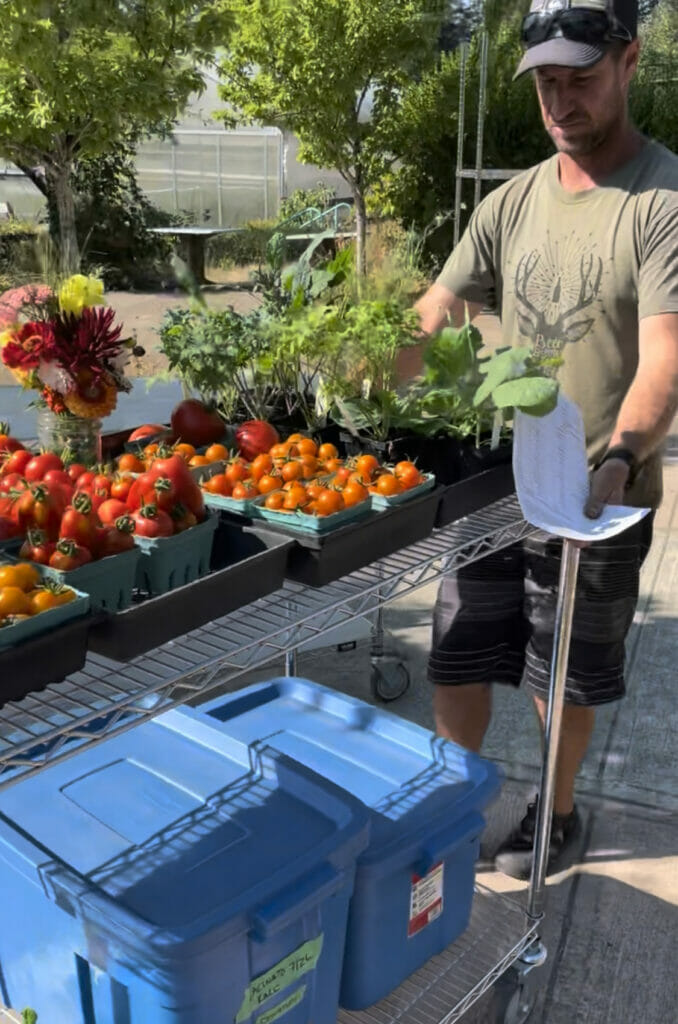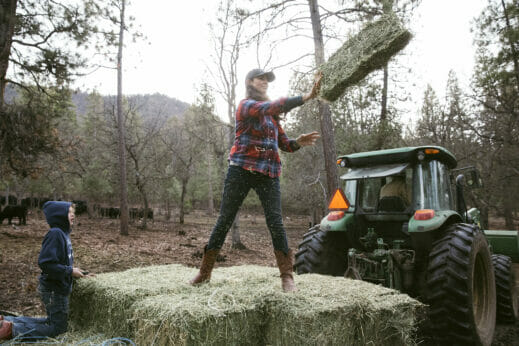Why farmers are increasingly banding together to take their products online, targeting consumers directly without the fuss of a physical market.

When Eat Local Sudbury Co-op closed back in 2018, Chantal Lewington and a group of fellow Ontario farmers gathered to discuss their options for getting products to the community. It was a worrying situation; the co-op was an important community outlet for their produce.
Lewington owned and operated Dalew Farms with her husband Dave and their children in Lavigne, Ontario. They had already begun selling online, direct-to-consumer. “In-person sales were taking too much away from our family time, and then we just had no privacy at home,” says Lewington. The Eat Local Co-op was one of the final storefronts to which Lewington still sold, and now that would no longer be an option.
The farmers weren’t sure how to move forward—until they took a look at Lewington’s website.
“[My husband] and I showed them our website and how we were doing online sales,” says Lewington. The group admired the friendly features and check-out functions for customers. They brainstormed together and came up with a solution. “[We could] create a website where multiple farms could list their products and have them all have the customer order them in one place and delivered all at the same time to save on shipping costs and packaging. It just took off from there,” she says.
Initially, the plan was to rotate other responsibilities such as marketing and social media among the participating farms.
There was some news coverage when four participating farms—Dalew Farms, Kipling Ridge Farms, Field Good Farms and Three Forks Farms—announced their online local food initiative called Click Fork.
“We did a one-year soft launch to see how it would go over,” says Lewington. “The farmers were selling out of a lot of products…It went really well.”

Chantal Lewington in ClickFork’s warehouse space. Photography courtesy of Chantal Lewington.
When the participating farmers noticed that the logistical and clerical work associated with their growth became too much to manage among them all, Lewington left her job as an X-ray technologist to manage Click Fork’s needs full time. In the four years since starting, dozens of participating vendors have joined, some spurred on by COVID restrictions on in-person shopping. The self-proclaimed Northeastern Online Farmers’ Market offers local products from more than 25 farms.
The loss of in-person farmers markets was not a crisis for Dalew Farms, which actually noticed a decrease in its food waste. One of the key differences of the online model is that people order it in advance; everything is sold even before it gets harvested.
“That’s a big plus to me,” says Lewington. “I hate wasting food, but that’s something we used to do at the in-person farmers markets. I hated having to come home with a bunch of extra produce. We would feed it to our pigs, but that’s not really feasible. You never know what you’re going to sell on a certain day [depending] how people feel or what the weather is like.”
Online farmers markets typically operate in a defined location, working with local farms in that region to market and ship fresh produce directly to consumers. They are becoming more popular; models such as Click Fork are thriving while their physical counterparts are suffering.
Digital direct-to-consumer selling within agriculture has been a trend of the pandemic, as physical stores have had to shut down and supply chain issues made getting shipping materials difficult at times. But with Click Fork, Lewington’s farm didn’t suffer during lockdowns; in fact, sales tripled during the pandemic.
Proponents of the online farmers market also argue that it is a more convenient system for food producers and customers; farmers save time and buyers are able to shop from their computer year-round while supporting local farms. Farmers do not have to take two days off work to travel to markets.
That’s one of the biggest perks for Chelsea Abbott, beekeeper and owner of Lenora Bee Apiary, and a member of Cow-Op.ca, a year-round non-profit co-operative in the Cowichan Valley Regional District in British Columbia. “I wanted to find a predictable means to sell my vegetables without having to spend more of my time standing at a farmers market,” says Abbott. “Before Cow-Op, I sold exclusively at [a] very classic, quintessential farmers market in the middle of the field. And you get to directly connect with those customers,” she says. “You get to tell them you know why your cauliflower is too small or why the carrots look the way they do this week or what’s doing well.”
Abbott says that, initially, she didn’t understand how these intangible opportunities would translate to an online marketplace, but she is now able to meet dedicated customers via Cow-Op’s network. She gets to know weekly customers with touches such as writing notes on their packages.
Since then, Abbott has, at various points, been a Cow-Op farmer, board member, employee and loyal customer. She’s now the general manager, handling the logistics of 60 to 80 co-operative members.
She says the stressful times of the last three years were more successfully weathered as part of the co-operative. “With the model of Cow-Op being a co-operative, they really stepped up and just made sure that we could get our produce directly to customers,” says Abbott. “That was also the time where, organizationally, we grew by about 500 percent.”
Seeing an increase in demand, the Cow-Op was able to offer home delivery, which until then had just been “a pipe dream.” Abbott says this increased the accessibility of Cow-Op’s products, adding that she sold everything she grew because of its offerings.

Mary Heffernan of Five Mary’s moved online before the pandemic, leaving her well-prepared for the changes in shopping habits. Photography courtesy of Five Marys.
Selling directly to consumers works for bigger operations as well. Close to the Oregon border in California, Mary Heffernan operates Five Marys Farm with her husband.They left the bustle of the Bay Area to raise the kind of cattle that they as restaurateurs wanted to see on the market. “Nine years ago, no one was really shipping meat,” says Heffernan. But online shopping was important to her, so the pair dug in and started experimenting with the best ways to reach their customers. “We were dead set on there has to be a way to do this so that we never have to leave the ranch…We spent about a year [trying] different packaging—different boxes, different liners, using dry ice versus gel packs…After a year, we got the secret sauce figured out—the best box, the best liner, the best way to make it affordable to ship overnight to customers.”
They had a website for customers to order by the cut. “If they wanted a bunch of filet mignon for a dinner party, we could accommodate that and have it show up on their doorstep the next day,” says Heffernan. That preparation years ago served them well during the pandemic.
“During the pandemic, there was never a time where people were more concerned about the security of knowing where their food was coming from and that it was going to show up. Never before had grocery store shelves been empty,” says Heffernan. “We would sell out almost instantly. People were calling crying like it was concert tickets: ‘There was a skirt steak in my cart and now it’s gone!’”
Critics argue that online farmers markets eliminate the face-to-face connections for farmers and their potential customers, losing opportunities to connect directly with consumers. Heffernan turned to Instagram for help breaking those barriers and to avoid spending her weekends stuck in traffic on the way to and from markets and deliveries.
“I shared our daily life—the good, the bad and the hardships of ranching…the beautiful new babies being born,” says Heffernan. “That’s really how we build our customer base…by being transparent on social media and letting people connect with us and feel like they’re part of our story. When they’re eating their meat, they know who was raising it.”
Heffernan coaches family farms in a course for small agriculture entrepreneurs, helping them set up a website and start selling directly to consumers.
“There’s so many farms and ranches that have been doing things one way for generations,” says Heffernan. “It’s so neat to see the people who have taken this course and…the change that they’re making in their operations; convincing their dad, ‘our kids aren’t going to be around to run this ranch if we don’t make a change, and direct-to-consumer is the way to go.’”
In my opinion this is a great idea. I hope it catches fire. Face-to-face is nice and the personal touch improves communication, but the issue of reduced loss alone makes this kind of marketing probably more valuable.
In the Columbia River gorge, we have about 10 seasonal in-person markets dotted throughout 75 miles. We are a rural region and that means a lot of driving for both farmers and consumers. I worked as a vendor at markets and it is physically demanding: harvesting the day before, packing in the morning, driving, unpacking and setting up the stand, standing for 3-5 hours talking and selling, enduring cold, heat, high winds and rainstorms, then packing everything back up, driving home, unpacking again. Some of the farmers worked three markets a week! Some local farmers created a farmer collective: we… Read more »
An answer to my prayers…a virtual farmers market! Woo hoo! Thanks for the article!
This is great and much needed! We have built an app that provides a 7 day a week farmers market for communities that can save farmers from market days similar to Click Fork. e-i-e-i-o…. (like Old MacDonald had a farm) allows farmers and gardeners to easily post what they have ripening on the ground or on the vine. Their neighbors and community can see these on a map — like Lyft or Uber — pick what they want and purchase. Buyers and sellers then connect by text to arrange pick-up. There is no commission or sales cost to the farmers… Read more »
Sounds great. Hope it catches on everywhere.